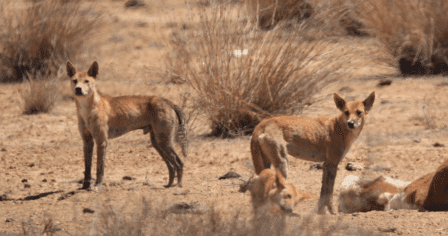
Wild dogs on a cow carcase in Western Australia.
A newly released scientific paper has found the argument to leave dingoes unrestricted in the environment due to their control of invasive pests such as feral cats and foxes is flawed.
The paper, ‘Stuck in the mud: Persistent failure of ‘the science’ to provide reliable information on the ecological roles of Australian dingoes’, was published in the September 2023 edition of Biological Conservation and provides a critical review of the past 30 years of research into the relationship between dingoes and other mesopredators, such as feral cats and foxes.
 The paper has found the majority of research did not have the scientific rigour to support conclusions that dingoes suppress feral cat and fox populations, with only eight studies over the past 30 years capable of assessing whether or not dingoes suppressed foxes and cats – and each of those showing they did not.
The paper has found the majority of research did not have the scientific rigour to support conclusions that dingoes suppress feral cat and fox populations, with only eight studies over the past 30 years capable of assessing whether or not dingoes suppressed foxes and cats – and each of those showing they did not.

Dr Ben Allen
Dr Ben Allen, Senior Research Fellow (Wildlife Management) at the University of Southern Queensland and one of the research paper’s authors, said the last decade has seen an increase in some groups seeking to have legislation or policy changed on the basis that dingoes suppress feral cats and foxes. Each of these changes have been rejected and the most reliable research supports such rejections.
“There is no doubt that dingoes play important ecological roles, but our research shows that suppressing foxes and cats isn’t one of them,” said Dr Allen.
“These findings will help decision-makers continue to determine best practice wild dog management to ensure negative impacts on Australia’s agricultural, biodiversity and social assets are minimised.”

Greg Mifsud
Greg Mifsud, National Wild Dog Management Coordinator, said the paper puts an end to persistent claims that the control of wild dogs/dingoes should be stopped due to their top-down regulation of feral cats and foxes.
“This paper reinforces what we have been seeing and saying for years now – wild dog and dingo management does not lead to an increase in fox and feral cat populations,” said Mr Mifsud.
“In fact, long term field studies undertaken by the Centre for Invasive Species Solutions and partner organisations demonstrate that strategic and targeted wild dog/dingo management programs have the potential to reduce fox numbers by up to 100% and feral cats by as much as 50%.
 If dingoes do not suppress feral cat and fox populations as this review paper demonstrates, then these control programs deliver a far greater conservation outcome for our native fauna.”
If dingoes do not suppress feral cat and fox populations as this review paper demonstrates, then these control programs deliver a far greater conservation outcome for our native fauna.”
“This means that government policy to allow the targeted control of wild dogs/dingoes for the protection of livestock, domestic pets and human health is not leading to increased predation by feral cats and foxes.”
This research provides landholders and organisations the ability to strike a balance in terms of dingo control measures to mitigate environmental and livestock production costs, whilst acknowledging the important ecological role dingoes play as apex predators, and their cultural significance.
Source: National Wild Dog Action Plan. For more information visit the National Wild Dog Action Plan website here.



We live on a nature refuge in far North Queensland. Our musky rat-kangaroo population was declining and also the cassowary chicks. Wildlife cameras showed dingoes active both day and night. After a 1080 baiting program with the local council the musky rat kangaroo population increased and the adult cassowaries returned. We hope they will be more successful this year raising chicks now that we have no dingoes on the property now.
Interesting to see this research has come out of the University of Southern Queensland, the same institution that prepared a proposal suggesting that there is no strong evidence of the environmental impacts of feral horses on the Australian Alps. That research was partly funded by the Brumby Alliance, I wonder who funded this paper?
Well said Sean and Jack.
This is not new research. It is a study of old research. Research that was, as stated in this article, poorly designed .
At best this study shows the need for more research with current technology into mainland dingoes where stable packs exist not just terorrised individuals.
Policy makers beware of confirmation bias!!
This seems a little too tailored to an industry narrative. Suffice to say more research is needed.
Well firstly, a few dingoes don’t really have much chance suppressing the plethora of cat and foxes out there.
Secondly, Ben Allen is renown for coming up constantly with interesting research which always suggests the opposite of what other scientists seem to suggest.
Lastly, anyone who has ever owned dingoes is very much aware of the very strong instinct dingoes have towards cats and foxes. Whilst they may not kill every one of them, they are certainly making a difference in some form of control which may include changing the hunting behaviour of these feral animals. And at the end of the day., if this research is accurate, how do you explain the fact that wild bilbies only exist where dingoes are? That dingoes exist where mallee fowl live?
Thank you Ben for this long over due for documenting what the dog affected community has known for many generations while our wildlife has been massacred, farming wrongfully blamed, domestic and free living animals misrepresented by fanatics and tearoom believers produced by agenda driven educational institutions. Evangelical believers that have a pathological problem with setting up their science to analyse reality so appropriate policies can be enacted.
Securing water, habitat, food security, soil regeneration. Many aspects including media to the urban majority. Darling dingo even on Frazer island chewing hard won tourist visitation run into the water like wallaby.
The other matter is the cooperation of dogs with foxes and pigs to exterminate wildlife with more imperative ecoservices than Asian dogs in plague proportions leading the extinction wave. People paid public money to salvage frogs raised in refrigeration containers to feed to pigs dogs foxes cats populations buoyed by rabbits. Bushfire then obliterating the evidence of decades of neglect negligence abandonment of rural minorities struggle with urban centric stupidity and belief little to do with reality. Science credibility destroyed.
Once again thank you but a long way to catch up to avoid irreversible consequences of lingering misconceptions generated in bushwalkers tearooms. Humanity has been biodiversity moderators for thousands of years since the ration dog arrived in Australia on the first boat. Since the fur industry acclimatised the rabbit and fox to slot in the presence of dog and cat add the pig too fire ant cane toad carp we are doing well to then marginalised rural minorities vilified and further marginalised in their efforts to restore balance progress. Crazy. Load up the loyal packhorse with Chinese dinner gongs, oak picnic tables, lounge chairs…… for the adventure looking for the inland sea over a few more sand dunes there before farming invented.